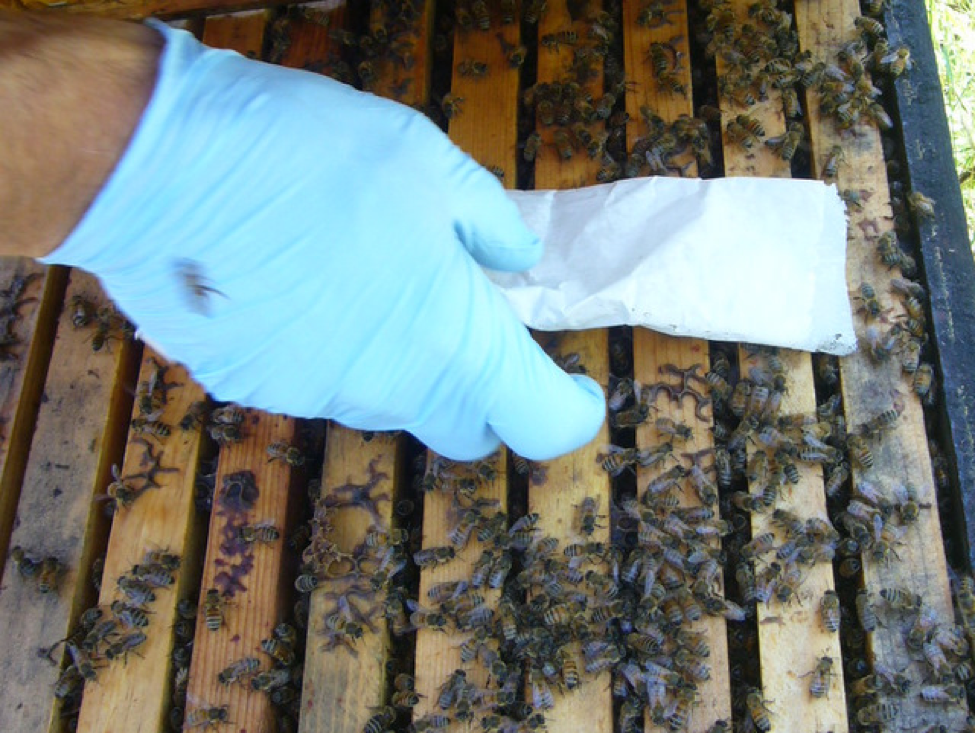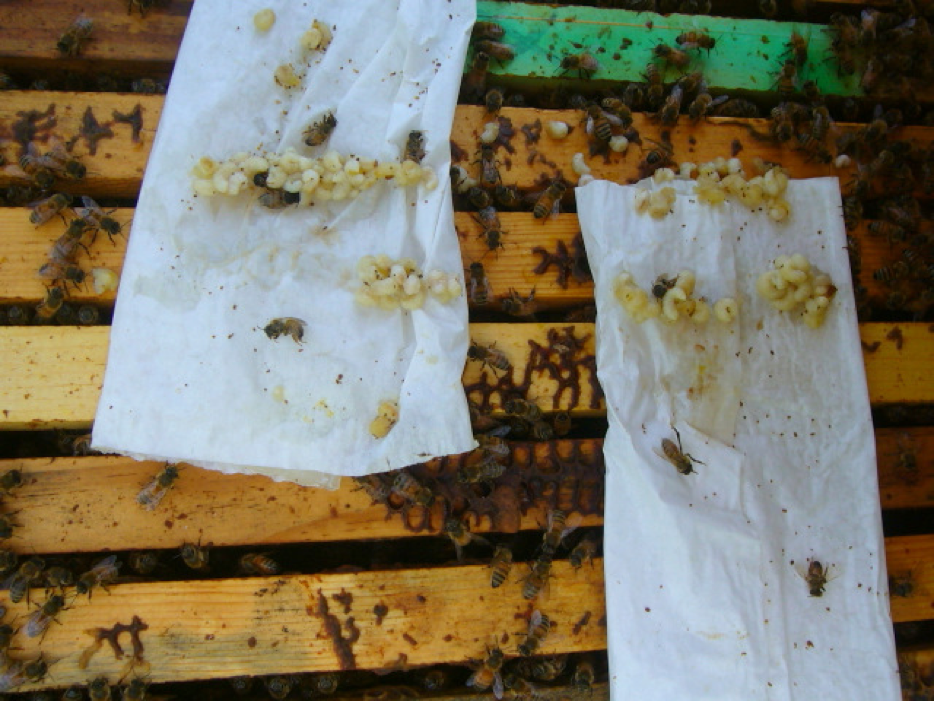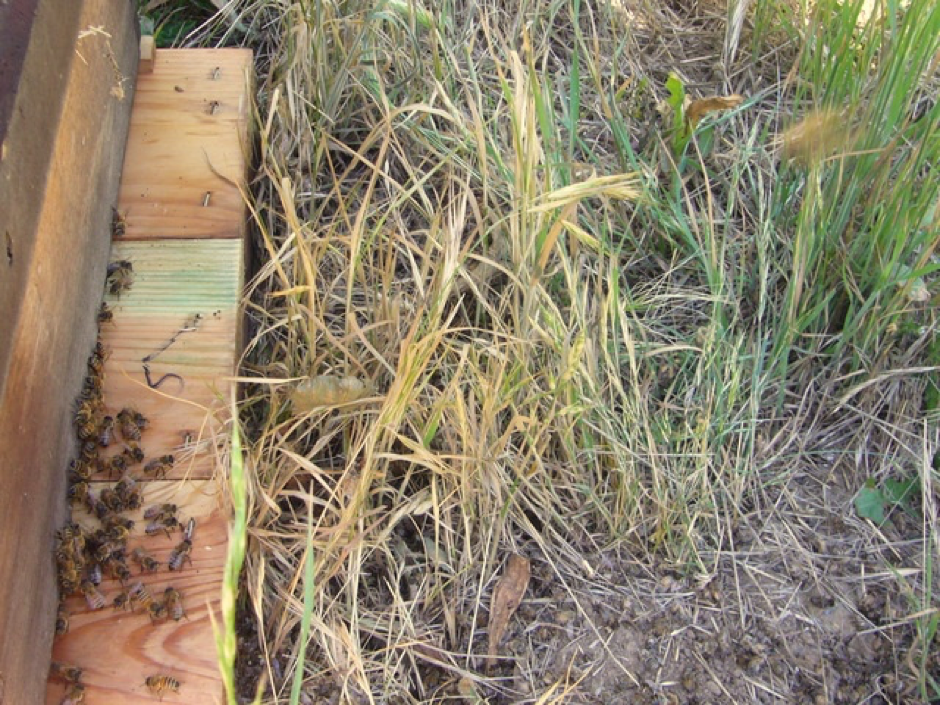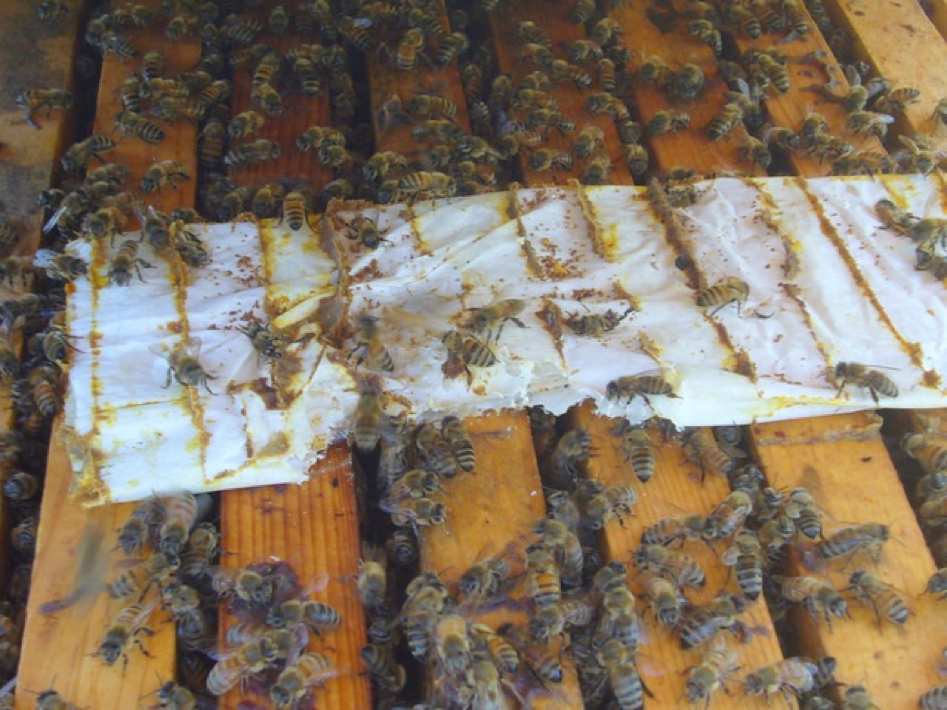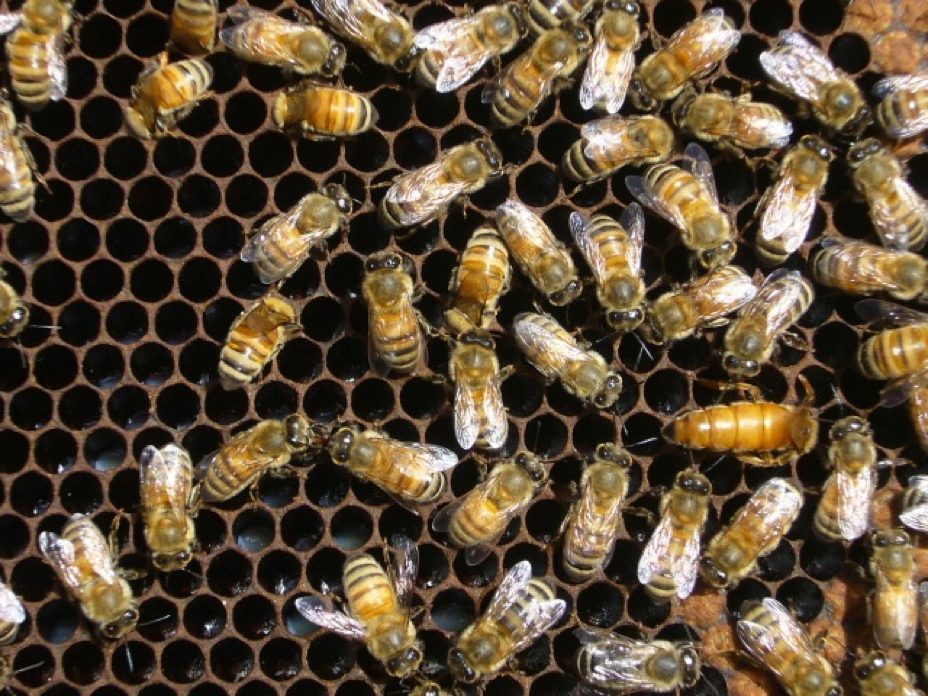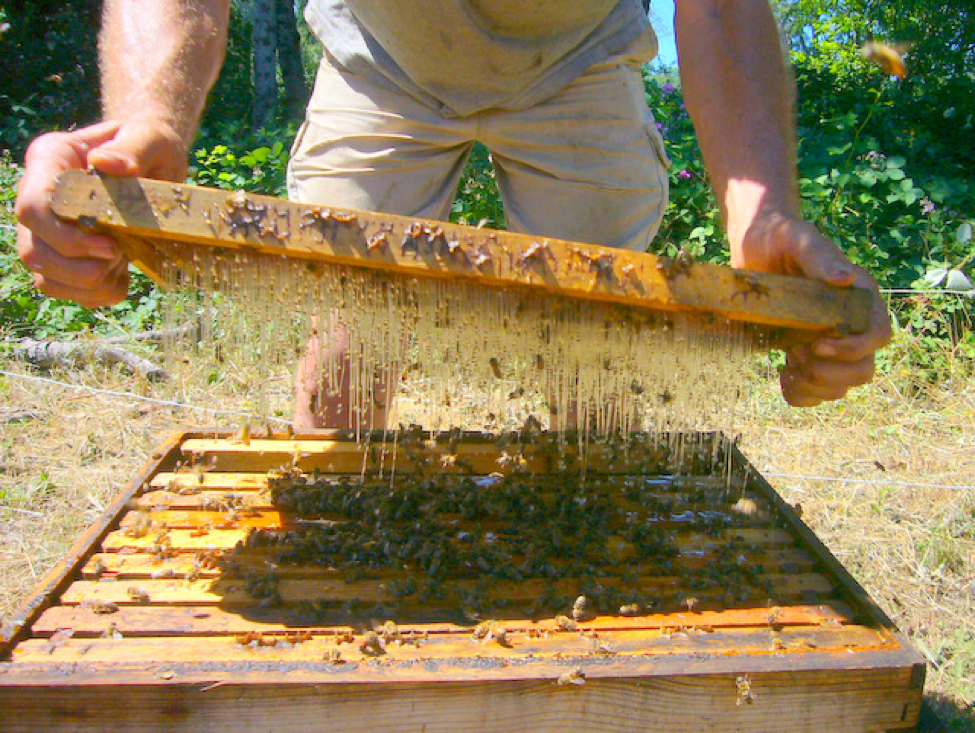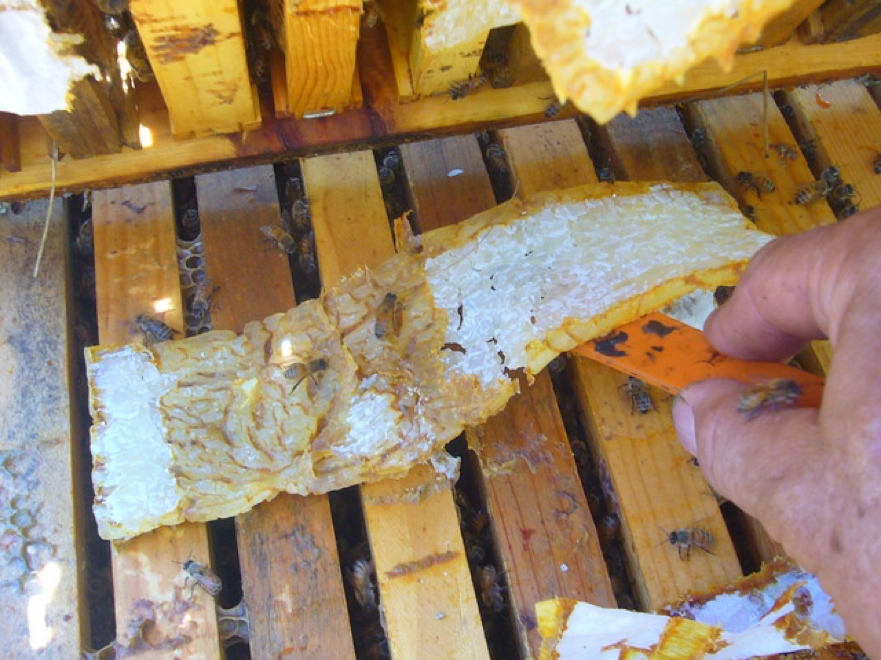An Early Summer Test of Mite-Away-Quick Strips(tm)
An Early Summer Test of Mite-Away Quick StripsTM
First published in ABJ September 2011
Randy Oliver
ScientificBeekeeping.com
In the February issue of this Journal, I wrote about a fall trial that I performed with the new formic acid delivery method—Mite-Away Quick Strips (MAQSTM). I had been impressed by their efficacy and ease of use. Imagine my surprise and dismay when I received a couple of phone calls from beekeepers in California’s Central Valley this spring lamenting that they had tried the strips, and that it looked like their hives had suffered from excessive queen losses!
In short order I was in communication with David VanderDussen, the developer of the strips, and worked with him and the beekeepers to resolve the issue (David went so far as to make a special trip to California to check things out personally).
The issue appeared to revolve around a few questions:
- Amount of ventilation—the hives involved had 3/8” beeways, rather than the 3/4” beeways on the hives that I had tested.
- The queens may have been old, and there was a good deal of natural queen loss and/or supersedure this spring.
- There appeared to be major brood loss.
- Application was just prior to the honey flow, and the beekeepers were worried about loss of crop.
- The stumper was that some colonies appeared to be unaffected, whereas others in the same yard appeared to be hit hard.
A New Trial
I set up a new trial in order to try to duplicate the situations reported to me. Since I live at higher elevation, I had the luxury of some time, since similar conditions would not arrive at my location for a few weeks. I set up a yard with hives containing 2nd-year queens, of the same strength as those with the reported problems, and built new bottom boards with the same 3/8” beeways.
Rainy weather delayed my trial a bit, then it broke and warmed just as the main flow came on. It’s probably best to simply present my experimental log:
6/8/11–Day 0
20 hives, doubles, 10 frames of drawn comb per box, 9-12 frame strength, all 2nd-year queens, light nectar flow on, temps in mid 70’sF.
Most bees in bottom boxes, and working up into 2nd box of drawn comb. Most (except # 6 & 7) had brood in upper box.
Poor weather in previous weeks, but lots of broodrearing due to syrup feeding & plentiful pollen—mostly young brood. All queens laying well.
Swapped to solid 3/8″ bottoms and checked all for queenrightness, and mite levels by alcohol wash.
6/9–Day 1
Ranked colonies by mite level. The two highest got half treatment (one strip only). The rest were assigned treatments alternating by mite levels.
6 treated with 2 strips (N = normal)
6 ditto, but upper box set back 3/4″ for increased ventilation per mfr recommendation (S = setback)
6 control sham treatments (folded paper), no setback (C = control)
2 with highest mite counts treated with 1 strip only, no setback (H = half treatment).
Weighed all hives to determine starting weights, in order to see whether treatment would affect the honey crop over the next few weeks.
Applied MAQS per mfr directions. Bearding began almost immediately in all treated hives.
Application of a MAQS. Test hives had from 9 to 12 frames covered with bees.
Typical set back of upper box for added ventilation.
6/10–Day 2 (24 hrs post treatment)
Bearding on most treated hives, more on non vented, but bearding at vents. Bearding even with single MAQS. Paper sham treatments mostly chewed away and removed. Per mfr’s caution, I did not inspect any brood frames.
Bees fairly close to strips and ignoring them. Noticable formic smell near entrances.
Brood carcasses on top of strips and on bottom boards, but varies from hive to hive. Appears to be less brood kill on vented, but not sure. No noticeable brood kill with single strip, but notable mite drop.
Typical bearding shortly after application. This behavior continued through the next day.
Bearding at setback was typical, but colonies appeared to tolerate the fumes better with setbacks.
At 24 hours post application, some colonies had dead older larvae piled on the strips and bottom boards. This brood kill was not apparent in all hives, and was very short term. Note the numerous killed mites that have also fallen.
6/12–Day 4 (72 hrs post treatment)
Grass browning in front of hives. Bees acting normally in treated hives–starting to chew out MAQS’s. Strips still smell of formic, but not as strong.
The acrid smell of formic acid is noticeable in the exhaust air coming from the entrance. The formic acid fumes killed the grass and weeds in front of the hive.
By 3 days after application, the strips had lost much of their smell, and the bees were either ignoring them or chewing them away.
6/15/11—Day 6 post treatment
All colonies acting normal. Strips have little smell. Bees appear to be ignoring strips.
6/18/11—Day 9 post treatment
Inspected frames. Substantial brood loss in all treated, but less in set backs and single strips. Those mostly still had some brood of all ages, and more sealed brood. Little sealed brood left in normal treatment.
By brood development math, queens shut down laying for 4-5 days, then resumed, often in outer frames or in top box.
Treated hives appear to have somewhat less adult bee strength compared to controls.
Only one lost queen (2-strip treatment). However, there had been queen loss in 2 of the group just prior to treatment, so not sure if from treatment.
All other queens looking fat and fit, and laying like mad. Lots of eggs and 1-2 day larvae, some in upper boxes, some in lower, large hive-to-hive variation.
A queen laying like mad. The young brood was swimmin’ in jelly. Other beekeepers have also commented that after the short break in egglaying, the queen and nurse bees get back to broodrearing with a vengeance.
There was little sealed brood remaining in the 2-strip unventilated hives, indicating that the open brood had been killed during treatment. However, not all colonies exhibited such loss. This photo is from a single-strip hive, in which the brood of all ages survived.
One colony suffered queen loss, although I have no idea whether it was from my mishandling, normal failure (others in the group had failed in the previous weeks), or from the strips. However, supersedure progressed normally, and the new queen was laying her heart out by the end of the trial.
7/7–Day 28 post treatment
The daily high temperatures for the first few days of heavy outgassing from the strips were in the mid to high 70’s. The hives were dark colored and in full sun.
Heavy nectar shake. Some hives starting to plug, so ended trial. Weather hot—about 90F.
Sealed brood looked very good in MAQS-treated hives, but also looked great in the controls!
There was a heavy nectar shake by the end of the trial, so it was a good test of any treatment effect upon nectar gathering. Thanks to helper Jed Nelson and his quick trigger finger for this shot!
All colonies, treated and control, looked great with nice brood patterns.
The bees do a poor job of removing the spent strips, and tend to propolize them in place. However, they can be easily scraped off with a hive tool.
Results
Since this was such a small data set, I’m not running any statistics, except for the medians (which, as opposed to means, ignore outlier values). By this date, a full brood cycle had been completed since the queens restarted at laying, so mite washes likely reflected the actual mite levels in the hives. The mite counts in the controls roughly doubled, as would be expected. Mite levels were reduced by about 90% in the unventilated treatments, and by about 77% in the ventilated hives.
Note: hive #6, which superseded, had no sealed brood, which means that its final mite count would be skewed higher. However, since I used medians to compare, it didn’t affect the group mite reduction percentage to any great degree.
Treatment with MAQS at the beginning of the flow did not appear to affect honey yields, as the 2-strip unventilated hives had the same weight gain as the control group. Oddly, the setback and 1-strip hives exhibited greater weight gain, but I have no idea whether that was a fluke, or whether a moderate amount of formic acid exposure stimulates foraging.
An Additional Trial
The manufacturer needed triplicate replication of “tolerance” trials of MAQS for European registration (trials to determine the safety of the product to bee colonies). Since there was an unusual heat wave in Ontario this June; David took advantage of it, and applied MAQS at or above the maximum temperature recommended by the label (92°F, 33°C). He has given me permission to share the details.
- 23 colonies in Langstroth style hives of various configurations, ranging from single brood chambers, no supers, up to two brood chambers and multiple supers.
- The three sites in the trial represented various typical bee yard locations: fully open to the sun and wind; partially shaded on a hillcrest, good air movement; full sun exposure most of the day, shaded late afternoon, well protected by dense tree surround.
- Colonies varied in strength from below the recommended 6-frame minimum (4 frame was the smallest at time of application, it expanded to 5 frames by the time of the post application examination) to greater than 20 frames.
- Queens were from 2009 or, if they had been superseded, 2010.
The colonies were evaluated on either Day 2 or 8 post treatment. Results: 1 queen loss; brood break in all other colonies varied from 0 – 4 days, with less of a break in larger colonies.
Discussion
Formic acid is an effective and well-proven miticide, but with devilish problems in handling safety and in controlling the vaporization rate such that it will efficiently kill the mites without excessively harming the bees (which tolerate the fumes surprisingly well). MAQS is the most user-friendly formic application method that I have seen to date.
Affects Upon Colony Behavior and Brood
Although the initial colony response (bearding, brood kill, and a break in egglaying) may be shocking when you first see it, the bees get over it in a few days and move on with their business. There is a surprisingly large colony-to-colony variation in response to formic fumes—bees in some hives largely ignore it, and there is no brood kill or egglaying break; in others you lose a week’s worth of brood. Larger colonies and those in better ventilated hives tend to suffer less from the fumes, but there are surprises—here’s a note that I received from one beekeeper:
“Yesterday I looked at 30 or so singles that got two strips under the lid, no supers–no apparent damage. One even still had an entrance reducer on. Go figger!”
Effect Upon Queens
Reports of excessive queen loss due to treatment appear to be largely unfounded, provided that the product is applied properly. Further communication with the affected beekeepers revealed that the natural queen loss rate of surrounding beekeepers during the same time period (but who hadn’t treated) was also unusually high. Here’s a follow-up email from a beekeeper who had earlier suspected major queen loss:
“I have now gone through all my treated colonies, and they are bouncing back pretty well, as forecast. The nurses obviously went some time without larva to feed as there is now a superabundance of pap in the cells, just like when cell starters go for days waiting for larvae to feed. Lost some queens, but not as bad as it looked previously. They are accepting the replacement queens well. If it cleans the mites as well as claimed, it is well worth it. I think that I may have overreacted somewhat.”
The results of this trial, and of others that I’ve seen the data from, do not indicate that MAQS treatment causes excessive queen losses.
One surprising anecdotal observation by others is that colonies deal with formic treatment better during subsequent applications—even if months later! Since few worker bees live that long, this observation suggests that it may be an effect of the queen response.
Efficacy of Mite Kill
The mite kill was pretty impressive—about 90% reduction at 4 weeks, as compared to almost a 100% increase in the control hives! This very limited data set suggests that the kill rate may have dropped when ventilation was increased by setting the upper boxes back.
On the other hand, I was surprised by the apparent high efficacy of the single strips. However, when I rechecked again on Day 43 post treatment, counts for the two single-strip hives (8 and 5 mites) were higher than those of the two 2-strip hives that I tested for comparison (3 and 0 mites). This is a very small data set, but appears to confirm the manufacturer’s findings that two strips are necessary for best mite control.
I was hoping to get adequate mite control by the application of a single strip, similar to the way in which I use a half treatment of Apiguard gel, since the single strip application appeared to be easier on the bees. However, a single-strip application may be enough for a relatively benign quick mite knockback (Disclaimer: I am not recommending any deviation from the label directions!).
Speaking of the label, the EPA’s requirement that applicators wear protective gear and respirators is nothing short of dumb! The product is extremely safe to apply, and that restriction will likely prevent many commercial operators from having employees apply the strips. This is extremely unfortunate, as MAQS could be a beekeeper’s salvation if mite counts get high while honey supers are on.
Effect Upon Honey Production
My concern that colony disruption by the strips would negatively affect my honey crop also appears to be unfounded. In fact, a brood break just at the start of the flow may be of benefit, as per the Killian method of comb honey production.
At this point I’ve reviewed or collected a fair amount of data on the results of MAQS application—the manufacturer is very cooperative, and IMHO has tested it thoroughly. However, MAQS is a new product, and as such, I suggest that you experiment with it on a portion of your hives first. I’m sure that with time, beekeepers will learn to tweak the timing and application for best results.
Disclaimer
I have no financial interest in MAQS. This study was funded by donations from Joe Traynor, the Virginia State Beekeepers Association, and other donors listed at ScientificBeekeeping.com.




